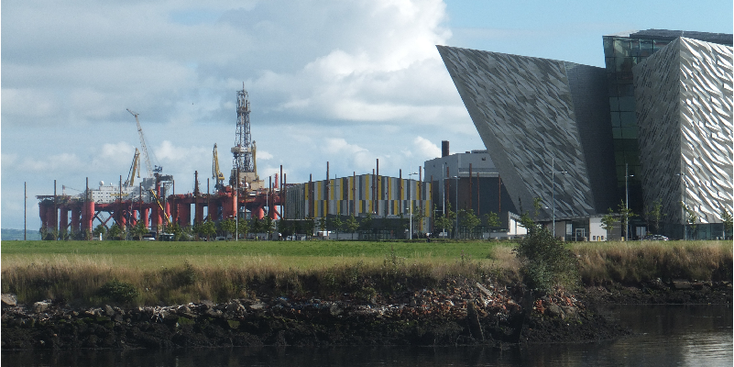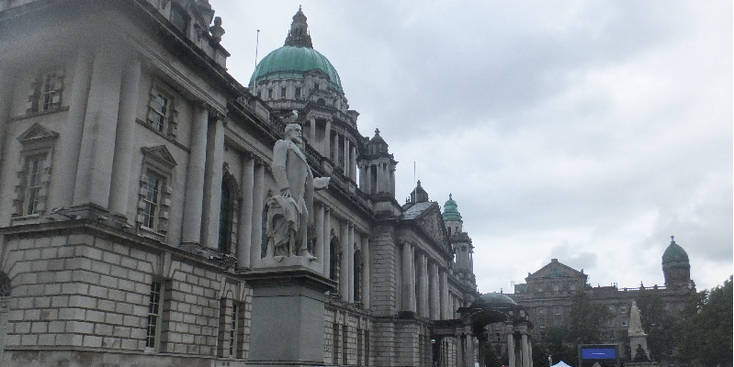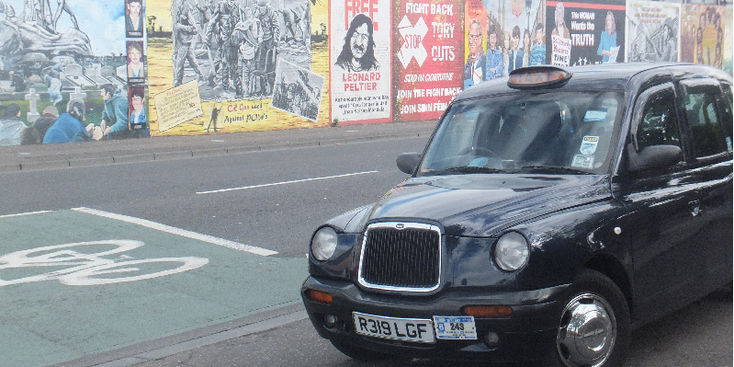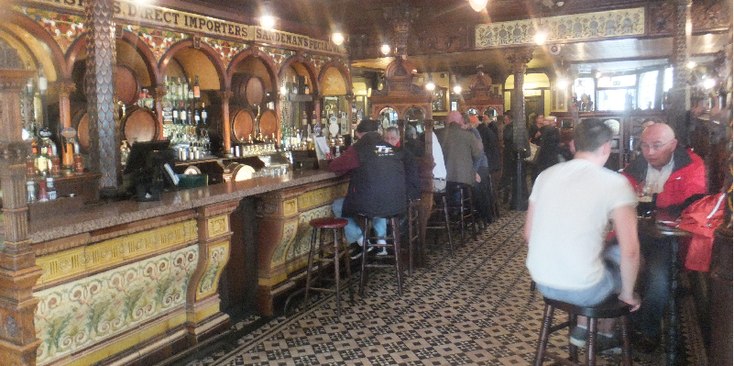Belfast
Places of Interest - Ireland (Northern)


introductions
Belfast is the capital and largest city in Northern Ireland. The name Belfast derives from the Irish Béal Feirste, or mouth of the Farset, the river where the city was built around. Belfast is located at the mouth of the River Lagan on the Belfast Lough, which is in direct contact with the Irish Sea. Not so remarkable that Belfast once had a large shipbuilding industry - the Titanic was built here. The city is fairly new, although it nevertheless has a number of appealing buildings. Belfast is surrounded by hills.
Most residents of West Belfast are Catholic. Some neighborhoods have a Catholic majority of as much as 90%. The city is still strongly divided by religion into segregated Protestant (Loyalist) and Catholic (Republican) neighborhoods. The majority of the neighborhood is recognizable by graffiti, paintings and flags at the entrances of the neighborhoods. To keep the population groups apart, the Belfast Wall has existed since 1969.
In recent years, the old dry docks and ports have disappeared from the cityscene and have been replaced by new urban projects with new investments. Famous singers like "Van Morrisson" and "Gary Moore" come from Belfast as well as football player George Best. Belfast child from the Simple Minds, a big hit from 1989, is about the division and gloom in the city of Belfast.
highlights

In the centre:
The most eye-catching building in the center of Belfast is the impressive city hall. Coming from 1903, this was built during the height of the Industrial Revolution that also held Belfast in its grasp. The beautiful Victorian building is a real masterpiece and can be viewed free of charge.
In the garden you can see a monument to the victims of the two world wars as well as an impressive memorial for the victims of the Titanic. Diagonally opposite the town hall is the linen hall library. Other icons are the Europe Hotel and the Grand Opera - both victims of IRA bombs in the Troubles.
Shopping is best in the pedestrian streets in and around High street which is one of the oldest streets of the city. Other notable buildings are the Queens university, dating from 1849 and the two former banks Ulster bank (1860) and Northern Bank (1769). Finally there is Belfast's own tower of Pisa - the Albert commemoration tower.

Titanic (quarter):
On the eastern side of the Lagan River, three major shipbuilding sites were built at the beginning of the 20th century. Here, among other things, the famous Titanic was built. Behind the modern Odyssey complex and the residential apartments you can still see different icons from that time.
First there is the Hamilton Graving Dock where the SS Nomadic is moored - this is the only ship that can still be seen of the company White Star Line, the owner who also owned Titanic. This ship can be visited. Behind it are the red brick buildings where the Titanic was created on the drawing board. Next to it stands the super deluxe in 2012 built (when Titanic would have existed for 100 years), Belfast Titanic; a multifunctional (museum) building with the Titanic Experience and lots of information.
On the square behind it the Ttianic and his sister Olympic were actually built. By using solid lines on the surface and metal poles you can get an idea of the actual dimensions and details of the ship. At the very back of the harbor you can see the old HMS Caroline ship from 1914 (WWI) - it is unfortunately not to be visited. Here is also the original pumphouse and the world's largest dry dock (see below). Next to it are the huge immense harbor cranes Samson and Goliath, owned by the shipbuilders Harland & Wolff.

West Belfast:
If you think of the capital of Northern Ireland, you imagine many politically tinted wall paintings. In West Belfast you can view these as well as the Peace Line that the religious ruffs must keep apart. The wall is 6 meters high and 4 km long. Shankill Road is the protestant counterpart of Falls Road where the Catholic population lives.
In addition to the many murals (including a large number of solidarity paintings) you can see where the Sin Feinn headquarters was located and where among others the hungry-striking IRA members (among others Bobby Sands) is buried (Milltown cemetery).
Flags, plaques, memorial gardens, banners, shops full of commercial religious stuff and painted lampposts and curbs will be your part.
Other sights:
-
Crumlin Road prison (www.crumlinroadgoal.com);
-
Cave hill with a view of the city and port of Belfast;
-
Transport museum where, among other things, the famous DeLorean was made in 1981. Commercial no success at all but became world-famous through the Back to the Future films;
-
Lisburn - terrain of the prison where once the infamous Maze / Long Kesh prison was full of political (read: IRA) prisoners were held - the famous hunger strike from 1981 with, among others, Bobby Sands dates from this prison.

history
The region where Belfast is located has been inhabited since the Bronze Age and remains of Iron Age forts can still be observed. At the mouth of the river was in 1177 for the first time a castle built by John de Courcy. His castle, and the adjacent settlement, were destroyed 20 years later, and the region came under the management of the O'Neill family. Early in the 17th century, Belfast became a place where the English and Scots settled, according to the plan of Sir Arthur Chichester, to colonize the area.
This resulted in a rebellion of the indigenous population in 1641. Later, Belfast attracted many Huguenots (French Protestants), who set up a widespread linen industry. More settlers were attracted and industries such as tobacco and shipbuilding flourished. In fact Belfast was actually the only city in Ireland that was part of the Industrial Revolution. Belfast also became the center of Irish Protestantism.
At the beginning of the 20th century, the city almost surmounted Dublin, although WWI would change this again.

The contrast between the Catholic and Protestant population groups only became visible in the 19th century. Since then, the city is plagued by the division between Catholics and Protestants, and was hit hard in the fight (The Troubles) between 1960 and 1997.
Half of the victims in this period fell in Belfast. The four-star Europe Hotel in the center was hit by the bombings of the IRA about 30 times, and has since become known as the hotel with the most bombings in Europe. Since the armistice of 1997, the number of violent outbursts has fallen sharply, and there is hope for a lasting peace.
Since then, Belfast has been growing, with many investments in the center (it is now a pedestrian zone with all major international stores), a sports stadium and a modern theater (The Waterfront Hall). The number of foreigners has also grown particularly; Chinese Brits, Hindus, Muslims and many Poles are settled in Belfast, which changed the city. In 2007, a historical file was signed between the Catholics (Martin McGuinness) and Ian Paisley (Protestant) - they would sit together in a coalition of the government.

tips & advice (2015)

The city has two airports, George Best Belfast City Airport, on the outskirts of the city at Holywood, and Belfast International Airport, near Lough Neagh. The big train station is Belfast Central Station (east of the city center) where all trains (including Dublin) leave. For trains to, among others, Larne and Derry you can (also) go to the Great Victoria Station which is next to the large (Europa Bus Center).
Belfast has two bus stations. The most important is Europa Bus Center (right behind the Europe hotel). The second station is located near the river and is called Laganside Bus Center - here buses go to the Antrim region. Finally, boats from different companies (Stena Lina, P & O etc.) depart from Belfast to Scotland, Isle of Man, Wales, England and for example France.
Belfast - Liverpool (boat): Stena Line boats leave to Liverpool from Belfast in the morning and evening. Price is £ 20 (excluding £ 5 for the use of credit card). The boat departs from Victoria Terminal (port No. 4) at 10:30 and arrives at Liverpool at 6:30 PM. With bus 96 you can reach the right terminal every 30 minutes from Upper Queen Street (near Donegal Square) - cost £ 2.
You must be present at the dock one hour in advance. Buses go every half hour - take the bus from 8:05 am and you are well in time. Ask the driver where to get out by reporting your destination. There are different bus stops for different destinations.

-
Name: Ulster museum
Address: Stranmillis Road
Price: free
Time: 10:00 - 17:00
Website: www.ulstermuseum.org.uk
Content:
This museum is located in the Botanical gardens in the south of the city near the Queen's University (Queens university). The museum is divided into several floors where nature, history and art form the main part. Beautiful skeletons of extinct animal species, treasures from the Spanish Armada ship Girona (found at the Giant's Causeway) and a real mummy from ancient Egypt.
-
Name: Thompson Pumphouse museum
Address: Thompson Graving Dock
Price: 6 pounds
Website: www.titanicsdock.com / www.titanicquarter.com
Content:
This only icon that still stands from the time that the Titanic was built can now be viewed on your own occasion. The pump house is located at the very end of the harbor and gives a view of the Stena Line harbor (Victoria) on the other side.
In the pump house you will see the original pistons and hydraulic machines that allow the Titanic in the original dry dock (which is located next to it) to be filled and drained by steam. You get to see two films about the time of the Titanic before you can walk in the gigantic big dry dock - here you can only really see how big these monster ships have been.


One of the nicest pubs in the south of the center of Belast is Lavery's. The building has different floors that play different styles of music. There will be a mixed audience of young and old, student and businessman and local and tourist. But you should definitely walk in at Crown Liquor Saloon - probably the most beautiful pub in Belfast and perhaps (Northern) Ireland.
Inside and out, this is a Gregorian beauty with a beautifully decorated wooden ceiling and small romantic boxes where you can drink something with friends. Other occasions are Maggie's May's near Ulster Museum and the American bar near the ports where many American soldiers were hanging around during the war.

-
Name: Paddy's Palace Belfast
Address: Lisburn Road 68
Price: 10 pounds (dormitory 6 persons)
Phone nr. : 9033 3367
Website: www.paddyspalace.com
Content:
This chain of hostels has for example a hostel in Dublin and Belfast and is located in the south of the center of Belfast within walking distance. There are different types of rooms including dormitories. These rooms actually a decent makeover as well as the reception and the rest too. Many things do not work (showers, toilets and also things in the kitchen) and the breakfast is scanty (but free) and also starts much too late (08:00) so people often miss it.
Also many guests waiting early in the morning waiting in the hallway waiting for it. There is a reasonable large kitchen and a lobby with a TV. WIFI is also present but does not work everywhere if it’s working at all. You get a key so you can enter the street next to it without knocking on the frontdoor every time.

If you want (like many other tourists do) you can book a black taxi tour. This will take you with a guide alias driver to
the Protestant and Catholic neighborhood to show you the most important wall paintings and to catch up on the history of the Troubles.
You can also do the tour by foot - there would be a brochure at the information desk with the most important wall paintings and explanations. When I visited Belfast the brochures weren’t there and wouldn’t be there for weeks. You can view the most important murals on the website www.belfast-murals.co.uk (including explanations).

see also:
LANDEN:
EUROPA:
Albanië * België * Bosnië-Herzegovina * Bulgarije * Denemarken * Duitsland * Engeland * Estland * Finland * Frankrijk * Griekenland * Hongarije * (Noord) Ierland * Italië * Kosovo * Kroatië * Letland * Litouwen * Luxemburg * Macedonië * Malta * Montenegro * NEDERLAND * Oekraïne * Oostenrijk * Polen * Portugal * Roemenië * Rusland * Schotland * Servië * Slovenië * Slowakije * Spanje * Tsjechië * Turkije * Zweden
NOORD EN CENTRAAL-AMERIKA:
Chili * Costa Rica * Cuba * Guatemala * Mexico * Nicaragua * Panama * Verenigde Staten
ZUID-AMERIKA:
Argentinië * Bolivia * Brazilië * Colombia * Ecuador * Peru
AFRIKA:
Botswana * Burkina Faso * Egypte * Ethiopië * Ghana * Kenia * Mali * Marokko * Namibië * Oeganda * Senegal * Tanzania * Tunesië * Zuid-Afrika
MIDDEN-OOSTEN:
Iran * Israël * Jordanië * V.A.E.
AZIE:
Armenië * Cambodja * China * Filipijnen * Georgië * India * Indonesië * Japan * Kirgizië * Laos * Maleisië * Mongolië * Myanmar * Nepal * Oezbekistan * Singapore * Sri Lanka * Thailand * Vietnam
OCEANIE:
Voor meer reisfoto's kijk op www.instagram.com/cheapskatetravel.nl:
© Cheapskatetravel.nl; 2018 (all rights reserved)


